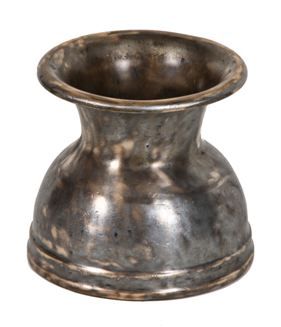late 19th century heavy cast bronze railroad passenger car spittoon with nickel plated finish
SOLD
Out of stock
SKU
UR-9369-11
a.c. clark & co., chicago, il.
heavy cast bronze late 19th century railroad passenger car spittoon or cuspidor containing underside markings. likely manufactured by the a.c. clark & co., chicago, il. the weighted "low-slung" spittoon retains the most of the original nickel-plated finish. in the late 19th century united states spittoons became a very common feature of saloons, hotels, stores, banks, railway carriages, and other places where people (especially adult men) gathered. brass was the most common material for spitoons. other materials used for mass production of spittoons ranged from basic functional iron to elaborately crafted cut glass and fine porcelain. spittoons are flat-bottomed, often weighted to minimize tipping over, and often with an interior "lip" to make spilling less likely. use of spittoons was considered an advance of public manners and health, intended to replace previously common spitting on floors, streets, and sidewalks spittoons were also useful for people suffering from tuberculosis who would cough up phlegm. public spittoons would sometimes contain a solution of an antiseptic such as carbolic acid with the aim of limiting transmission of disease. with the start of the 20th century medical doctors urged tuberculosis sufferers to use personal pocket spittoons instead of public ones; these were jars with tight lids which people could carry with them to spit into. similar devices are still used by some with tuberculosis. after the 1918 flu epidemic, both hygiene and etiquette advocates began to disparage public use of the spittoon, and use began to decline. chewing gum replaced tobacco as the favorite chew of the younger generation. cigarettes were considered more hygienic than spit-inducing chewing tobacco. while it was still not unusual to see spittoons in some public places in parts of the us as late as the 1930's, vast numbers of old brass spittoons met their ends in the scrap drives of world war ii.
WORDLWIDE SHIPPING
If required, please contact an Urban Remains sales associate.
NEW PRODUCTS DAILY
Check back daily as we are constantly adding new products.
PREMIUM SUPPORT
We're here to help answer any question. Contact us anytime!
SALES & PROMOTIONS
Join our newsletter to get the latest information

























